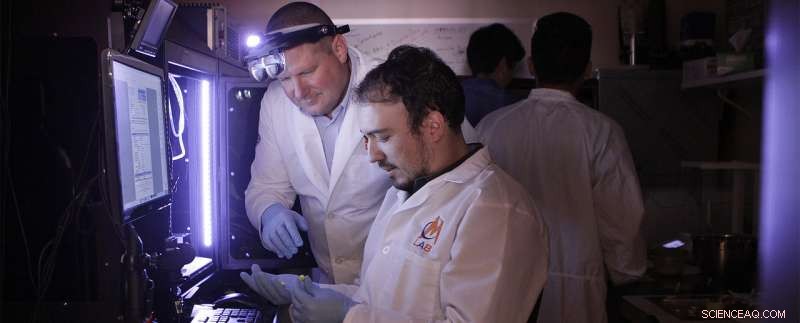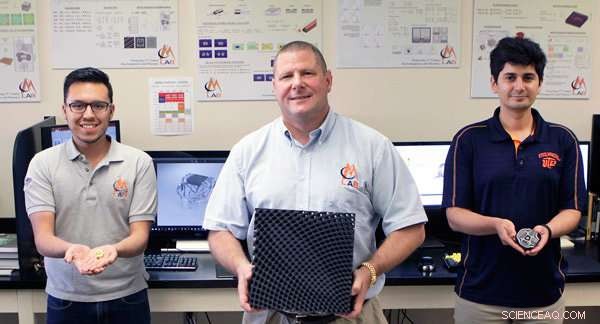
Raymond C. Rumpf, dottorato di ricerca, lavorando con uno studente nel laboratorio EM dell'Università del Texas presso il College of Engineering di El Paso. Credito:Comunicazioni UTEP
Raymond C. Rumpf, dottorato di ricerca, e il suo team EM Lab sono motivati da sfide estreme che altri potrebbero considerare impossibili.
Il professore Schellenger in ricerca elettrica presso l'Università del Texas presso il College of Engineering di El Paso guida il laboratorio EM, uno spazio dedicato ai pionieri dell'alto rischio, concetti ad alto profitto nell'elettromagnetismo e nelle tecnologie fotoniche abilitati dalla stampa 3D.
"Teniamo un cartello sopra il nostro cestino che dice, "Pensieri incrementali" su di esso con una freccia rivolta verso il basso, " Rumpf ha detto per scherzo. "Se pensiamo che si possa fare, probabilmente non siamo interessati".
Ma non c'è niente di divertente nelle scoperte che sono state fatte all'interno dei confini del laboratorio. Dal 2010, Rumpf e il suo team di ricercatori hanno visto la realizzazione di diversi progetti rivoluzionari, compreso lo sviluppo di una superficie selettiva a frequenza ultraelevata e di una delle antenne dielettriche più sottili al mondo. Inoltre, il team ha registrato quella che è probabilmente la curva più stretta di un raggio ottico. Però, l'ultima svolta di EM Lab è ancora la più ambiziosa e di vasta portata. All'inizio di quest'anno, ricercatori hanno completato il primo vero tridimensionale, circuito volumetrico utilizzando un processo completamente automatizzato. È un'impresa che, secondo Rumpf, potrebbe cambiare il paradigma di come vengono progettati e realizzati i prodotti con funzionalità elettrica.
"Questo è un passo molto significativo e un risultato potenzialmente dirompente, " Rumpf ha detto. "Ci sono molti altri grandi gruppi di ricerca che hanno inseguito questo. È ciò a cui tutti in questo campo stanno lavorando e di cui parlano, eppure nessuno l'ha ancora raggiunto. È una specie di Santo Graal per i circuiti stampati 3D, ed è stato realizzato qui all'UTEP."
La ricerca sulla tecnologia del circuito 3-D/volumetrico è nata dalla nozione che un circuito tridimensionale offre più libertà per rendere i circuiti più piccoli, più leggero ed efficiente. La stampa 3D consente loro di essere fabbricati in fattori di forma arbitrari che possono essere integrati in qualsiasi oggetto o superficie. Il concetto offre molte opportunità per l'industria manifatturiera. Rumpf ha affermato che questa recente svolta è il risultato di anni di ricerca e di assemblaggio di tutti gli strumenti e i processi necessari per realizzare.
"Gli ultimi tre anni sono stati spesi per sviluppare strumenti CAD (progettazione assistita da computer) futuristici, per produrre circuiti 3-D/volumetrici. Questi strumenti non esistono da nessun'altra parte, " ha detto Rumpf.
La realizzazione di questi risultati ha richiesto il lavoro di un team di ricercatori di EM Lab:Gilbert Carranza, Ubaldo Robles, Cesar Valle e lo stesso Rumpf.
Carranza, uno studente di dottorato, ha iniziato la sua ricerca in EM Lab come studente universitario due anni fa. Quando Rumpf ha presentato la sfida di trovare un modo per progettare circuiti in tre dimensioni, Carranza ha colto al volo l'occasione. Ha utilizzato un software CAD open source per integrare le sue funzioni personalizzate che hanno permesso all'EM Lab di progettare veri circuiti 3D.
"Ho costruito uno strumento personalizzato che ci permette di posizionare componenti elettrici in qualsiasi posizione e con qualsiasi orientamento, "Carranza ha detto. "Possiamo instradare le interconnessioni elettriche in tutte e tre le dimensioni seguendo percorsi lisci".
Carranza ha lavorato per un anno sul software per produrre la prima versione.
"Non potremmo andare da nessuna parte oltre a questo, " Ha detto Carranza. "Non avevamo lo strumento necessario per tradurre effettivamente il mio progetto in qualcosa che potesse essere letto dalla nostra stampante 3D".
Entrano Robles e Valle. I due sono anche dottorandi e ricercatori di EM Lab che trascorrono molte ore nella sala stampa 3D. Gran parte dell'ultimo anno è stato speso cercando di colmare il divario tra il software di Carranza e il processo di stampa. All'inizio dell'estate, Robles ha completato con successo un'interfaccia in grado di convertire il progetto del circuito in codice che la stampante può leggere per costruire il circuito in un unico passaggio. Da li, Valle e Carranza hanno messo a punto il processo e prodotto il primo circuito 3-D/volumetrico al mondo utilizzando il loro processo automatizzato.

Raymond C. Rumpf, dottorato di ricerca, centro, sta con due dei suoi assistenti di ricerca laureati, Gilbert Carranza, sinistra, e Cesare Valle. Il trio lavora nell'EM Lab di Rumpf presso l'Università del Texas presso il College of Engineering di El Paso. Quest'anno, the lab developed the world's first 3D/volumetric circuit. Credit:Laura Trejo / UTEP Communications
"Getting the CAD, code generator, and 3-D printer to play along well together proved the most difficult step, " Valle said. "Typically, when you make a circuit, it's two steps. You start with a thin sheet of plastic. Oltre a ciò, you form metal traces, then put electrical components onto that. What our tool does that is unique is it combines these processes, and it does it in three dimensions with complete design freedom. We are now able to load 3-D files, hit 'run' and out comes the part. Literally 'File, ' 'Print.'"
Rumpf said there is a huge array of applications for this technology, which was developed using funding from the U.S. Army Research Laboratory at Aberdeen Proving Ground, Maryland, and the Air Force Research Laboratory at Wright-Patterson Air Force Base, Ohio. With the ability to build circuits into any shape or surface, electronics can be built into anything with virtually no added size or weight.
"We can make circuits in any form or fashion, " Rumpf said. "You could put circuits in munitions, in eyeglasses, in shoes, and even in coffee mugs. You can be at a restaurant drinking coffee and, when the liquid gets down to a certain level the server gets notified before you have to say anything. It's about making electronics ubiquitous in many different things."
He added that another aspect of this innovation will be the ability for small businesses that can buy a 3-D printer to become electronics manufacturers with the ability to produce products where each is customized.
"Nel futuro, I don't think you will see places, such as major electronics manufacturing companies, churning out billions of things and dominating the market nearly as often, " Rumpf said. "Instead, you may have thousands of small businesses in the U.S. churning out thousands of products, both mass-produced and customized. Our 3-D circuit technology may be the first step to change the paradigm of circuit manufacturing. And it may enable us to exploit and incorporate new physics in traditional planar (2-D) circuitry.
For the EM Lab graduate researchers, the effort provided real-world experience in the development of a technology that holds great promise to revolutionize manufacturing of circuits. It is something they credit with spurring them to continue their academic careers past their undergraduate journeys. Their breakthrough also offers the opportunity that a business could be incubated in El Paso to commercialize the EM Lab's multiple achievements, something that would keep them closer to home.
"I want to stay here in El Paso, " Carranza said. "My whole life is here. I didn't think UTEP had anything like this. I expected to graduate then go somewhere else. I never thought I was going to be doing research that could literally change the world until I stumbled upon the EM Lab." Valle echoed those views. "Four years ago, if you asked me if I wanted to get a Ph.D., I would have said, 'no, '" Valle said. "Now, I'm close to getting it. I never considered that UTEP had such incredible opportunities for research like what is happening in the EM Lab."
Rumpf said there is something about his student researchers that elevates the level of work that can be conducted at the EM Lab.
"What we do is extremely difficult and high-risk, " Rumpf said. "EM Lab students spend years just developing the tools they need to do their research. They know when they start their research, they're probably going to fail many times, because we are pushing ourselves that far. The type of person willing to take on this daunting level of risk and challenge is what UTEP and El Paso have to offer. It's a personal philosophy, and I don't think we could have accomplished this any other place but here."